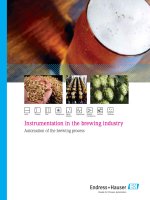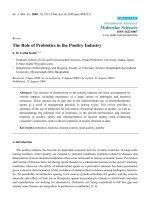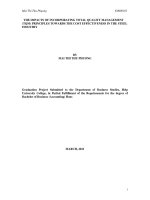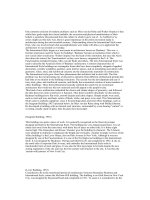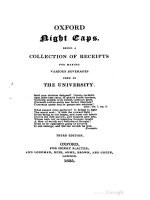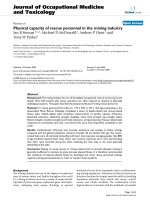Sewing Thread - Types of Sewing Thread being Used in The Garments Industry of Bangladesh
Bạn đang xem bản rút gọn của tài liệu. Xem và tải ngay bản đầy đủ của tài liệu tại đây (349.05 KB, 11 trang )
Southeast University
Department Of Textile Engineering
I/A 251,252 Tejgaon Dhaka Bangladesh
prepared by : Mazadul Hasan sheshir
Sewing Thread
Sewing Thread
Types of Sewing thread being used in the garments
Types of Sewing thread being used in the garments
industry of Bangladesh
industry of Bangladesh
1.Polyester Corespun Thread
1.Polyester Corespun Thread
2.Spun Polyester Thread
2.Spun Polyester Thread
3.Staple Spun Cotton Thread
3.Staple Spun Cotton Thread
4.Textured Polyester Thread
4.Textured Polyester Thread
5.Polyester Cotton Corespun Thread
5.Polyester Cotton Corespun Thread
6.Trilobal Polyester Thread
6.Trilobal Polyester Thread
Sewing Thread (Contd.)
Sewing Thread (Contd.)
1.
1.
Polyester Corespun Thread:
Polyester Corespun Thread:
This type of thread is produced by spinning staple
This type of thread is produced by spinning staple
polyester fibre around a core of high tenacity continuous
polyester fibre around a core of high tenacity continuous
filament polyester in yarn-spinning operation. Two or
filament polyester in yarn-spinning operation. Two or
more of these composite yarns are then twisted together
more of these composite yarns are then twisted together
to give the necessary size and tensile strength.
to give the necessary size and tensile strength.
e.g. Epic(Coats).
e.g. Epic(Coats).
Uses: Mainly used in topstitching of shirts, blouses,
Uses: Mainly used in topstitching of shirts, blouses,
trousers, sportswear , jeans & work clothes.
trousers, sportswear , jeans & work clothes.
Sewing Thread (Contd.)
Sewing Thread (Contd.)
Key Characteristics
Key Characteristics
:
:
-
Exceptionally strong.
Exceptionally strong.
-
The continuous filament core (Having high tenacity)
The continuous filament core (Having high tenacity)
provides superior strength while the staple polyester
provides superior strength while the staple polyester
cover helps to protect the inner core from damage due
cover helps to protect the inner core from damage due
to needle heat.
to needle heat.
-
Its resistance to abrasion helps ensure long seam life in
Its resistance to abrasion helps ensure long seam life in
a wide variety of materials.
a wide variety of materials.
-
Fine threads can be used for delicate fabric without
Fine threads can be used for delicate fabric without
compromising on strength, thereby avoiding problems
compromising on strength, thereby avoiding problems
like seam pucker.
like seam pucker.
Sewing Thread (Contd.)
Sewing Thread (Contd.)
2.
2.
Spun Polyester Thread:
Spun Polyester Thread:
Staple polyester fibres are spun into polyester yarn. Then
Staple polyester fibres are spun into polyester yarn. Then
two or more of spun polyester yarns are twisted together
two or more of spun polyester yarns are twisted together
to produce spun polyester thread.
to produce spun polyester thread.
e.g. Astra (Coats)
e.g. Astra (Coats)
Key Characteristics:
Key Characteristics:
-
High tenacity of polyester ensures greater strength and
High tenacity of polyester ensures greater strength and
thereby high abrasion resistance.
thereby high abrasion resistance.
-
Very least amount of shrinkage (less than 1%) compared
Very least amount of shrinkage (less than 1%) compared
to cotton thread.
to cotton thread.
Uses:
Uses:
Mainly for overedging. Also used for general seaming
Mainly for overedging. Also used for general seaming
of shirts, trousers, knitwear, jackets, blouses etc.
of shirts, trousers, knitwear, jackets, blouses etc.
Sewing Thread (Contd.)
Sewing Thread (Contd.)
3.
3.
Staple Spun Cotton Thread:
Staple Spun Cotton Thread:
Normally long staple cotton fibres are spun into cotton
Normally long staple cotton fibres are spun into cotton
yarn. Then two or more ply of spun cotton yarn are
yarn. Then two or more ply of spun cotton yarn are
twisted together to produce spun cotton thread.
twisted together to produce spun cotton thread.
e.g. dymax (Coats)
e.g. dymax (Coats)
Key Characteristics:
Key Characteristics:
-
100% cotton thread have relatively low strength and
100% cotton thread have relatively low strength and
elongation compared to those in synthetic thread ,
elongation compared to those in synthetic thread ,
therefore they need relatively light sewing tension and
therefore they need relatively light sewing tension and
high stitch densities.
high stitch densities.
-
Very high amount of shrinkage compared to synthetic
Very high amount of shrinkage compared to synthetic
thread.
thread.
Sewing Thread (Contd.)
Sewing Thread (Contd.)
3.
3.
Staple Spun Cotton Thread:
Staple Spun Cotton Thread:
- During sewing , cotton thread is not damaged at high
- During sewing , cotton thread is not damaged at high
temperature generated by needle.
temperature generated by needle.
- 100% cotton thread is mercerized (treatment with caustic
- 100% cotton thread is mercerized (treatment with caustic
solution under tension) to provide greater luster and
solution under tension) to provide greater luster and
higher strength.
higher strength.
Uses:
Uses:
Mainly used in sewing cotton garments that are to be
Mainly used in sewing cotton garments that are to be
post dyed.
post dyed.
Sewing Thread (Contd.)
Sewing Thread (Contd.)
4.
4.
Textured Polyester Thread:
Textured Polyester Thread:
-
Made from textured continuous polyester filament.
Made from textured continuous polyester filament.
(Note- texturing means modification by applying crimp to the
(Note- texturing means modification by applying crimp to the
filament) . e.g. Gramax (Coats).
filament) . e.g. Gramax (Coats).
Key features:
Key features:
-
Provides high softness and comfort.
Provides high softness and comfort.
- High extensibility and seam strength enhance higher seam
- High extensibility and seam strength enhance higher seam
security.
security.
Uses:
Uses:
Mainly used in “next to the skin” seams for high
Mainly used in “next to the skin” seams for high
softness .e.g. underware, swimwear, babywear etc.
softness .e.g. underware, swimwear, babywear etc.
Also widely used in overlocking and covering stitches for high
Also widely used in overlocking and covering stitches for high
extensibility and seam security.
extensibility and seam security.
Sewing Thread (Contd.)
Sewing Thread (Contd.)
5.
5.
Polyester Cotton Corespun Thread:
Polyester Cotton Corespun Thread:
- Made of polyester filament in the core and staple cotton
- Made of polyester filament in the core and staple cotton
fibre which wraps polyester filament. Two or three plies of
fibre which wraps polyester filament. Two or three plies of
this yarn are twisted together to make thread.
this yarn are twisted together to make thread.
e.g. dual duty (Coats).
e.g. dual duty (Coats).
Key features:
Key features:
- This thread has been developed to improve the properties
- This thread has been developed to improve the properties
cotton and to get the opportunities of both cotton and
cotton and to get the opportunities of both cotton and
polyester fibre.
polyester fibre.
- Very low shrinkage, good strength and cotton core protects
- Very low shrinkage, good strength and cotton core protects
poly core from needle heat and high ironing temperature.
poly core from needle heat and high ironing temperature.
Uses
Uses
: fine cotton denim shirts , outdoor wear etc.
: fine cotton denim shirts , outdoor wear etc.
Sewing Thread (Contd.)
Sewing Thread (Contd.)
6.
6.
Trilobal Polyester thread
Trilobal Polyester thread
:
:
- Newly developed polyester fibre to improve the dullness of
- Newly developed polyester fibre to improve the dullness of
usual polyester fibre.
usual polyester fibre.
-Trilobal poly is a multiple filament, twisted, high-sheen
-Trilobal poly is a multiple filament, twisted, high-sheen
continuous fiber thread. It has the bright appearance of
continuous fiber thread. It has the bright appearance of
rayon or silk. Triangular shaped fibers reflect more light
rayon or silk. Triangular shaped fibers reflect more light
and give an attractive sparkle to textiles.
and give an attractive sparkle to textiles.
Uses
Uses
: embroidery for garment.
: embroidery for garment.

